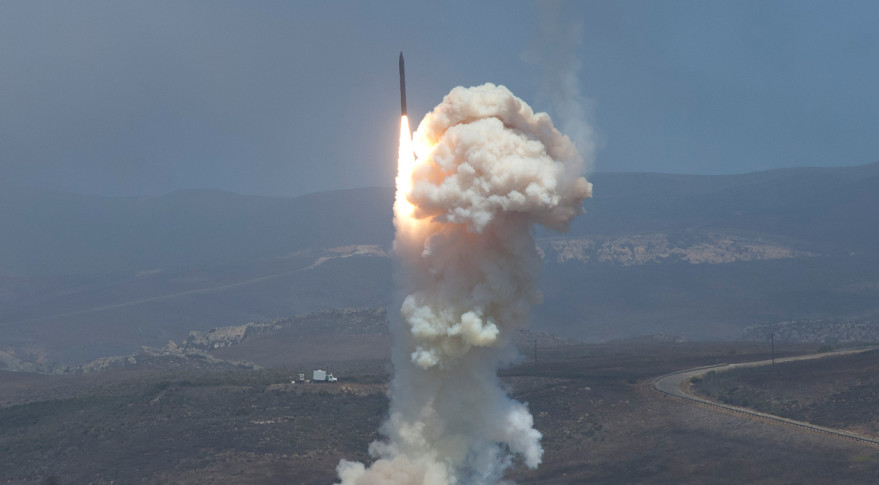GAO: Missile Defense Agency Is Using 'High Risk' Approach for Additional Interceptors

WASHINGTON – The U.S. Missile Defense Agency is using a high-risk acquisition approach to bolster its arsenal of ground-based interceptors and counter growing threats from North Korea, according to a new report from the Government Accountability Office.
"To achieve its current fielding goal, MDA is relying on a highly optimistic, aggressive schedule," the Feb. 17 report said. As a result, the agency is "compromising interceptor reliability and extending risk to the warfighter."
The Defense Department announced in March 2013 a new strategy to offset threats from North Korea that would add 14 interceptors to ground-based missile defense sites in California and Alaska. [The Most Destructive Space Weapons Concepts]
Currently the MDA has a total of 30 interceptors at Vandenberg Air Force Base in California and in Fort Greely, Alaska.
To meet the White House's goals, Navy Vice Adm. James Syring, the head of the MDA, said in January the agency plans to have 37 interceptors in place by the end of the year and 44 by the end of 2017.
But the GAO pointed to two areas where they said the agency needed to do more testing before deploying additional interceptors.
First, the congressional watchdog chided MDA for beginning production of a new version of the kill vehicle, known as the Capability Enhancement-2 Block 1, before it has performed its first intercept test.
Get the Space.com Newsletter
Breaking space news, the latest updates on rocket launches, skywatching events and more!
"This approach runs counter to best practices for DOD's weapon system acquisition process, which state that the demonstration flight test should be conducted before starting production," the report said.
Syring said during a Feb. 9 press briefing that the new version of the interceptor will be part of a flight test later this year. Deliveries of the CE-2 Block 1 are expected to begin in fiscal year 2017, the GAO report said.
Boeing is the prime contractor on the ground-based midcourse defense system and Raytheon builds the kill vehicle.
Second, the GAO is worried that MDA does not have a rigorous enough testing schedule for new alternate divert thrusters (ADT) on its kill vehicles. The primary purpose of a Jan. 28 flight test was to gather more data about the kill vehicle's divert and attitude control system, which helps steer the kill vehicle into its target. But GAO investigators said reduced testing during production of the kill vehicle "increases the risk of workmanship errors going undetected and failures being discovered during flight."
"Although each ADT produced is to undergo some functional and environmental testing, MDA does not intend to 'hot-fire' each ADT before integration —a test that verifies proper performance and workmanship," the report said. "As a result, the first time the ADT will be fired is in flight."
The report also echoed longstanding claims about the missile defense system's effectiveness.
The GAO cited two recent reports from the Pentagon's chief weapons tester that the system has "a partial capability against small numbers of simple ballistic missile threats launched from North Korea and Iran" but that there had been insufficient testing to demonstrate whether an "operationally useful defense capability exists."
Specifically, the GAO said the agency's ground-based midcourse defense system has not demonstrated that it can intercept an intercontinental ballistic missile or perform what's known as a salvo intercept, where two or more interceptors chase the same target, a likely scenario during an attack.
"MDA has not demonstrated through flight testing that it can defend the U.S. homeland against the current missile defense threat," the report said.
The Defense Department has planned those tests for the near-term.
During a January speech here at the Center for Strategic and International Studies, Syring said the first intercept test using an ICBM target is planned for the end of this year and the first salvo intercept test of the ground-based midcourse defense system is planned for late 2017.
This story was provided by SpaceNews, dedicated to covering all aspects of the space industry.
Join our Space Forums to keep talking space on the latest missions, night sky and more! And if you have a news tip, correction or comment, let us know at: community@space.com.
Mike Gruss is a veteran defense reporter and Editor-in-Chief of Sightline Media Group, which includes Army Times, Air Force Times, Dense News, Military Times and Navy Times. From 2013 to 2016, Mike served as a Senior Staff Writer for SpaceNews covering national security space programs and military space policy in the U.S. Congress. Mike earned a bachelor's degree in English and American Studies from Miami University and has previously wrote for the Journal Gazette in Fort Wayne, Indiana and the Virginian-Pilot in Virginia before joining SpaceNews. Prior to joining Sightline in 2017, he was a senior editor of FedTech magazine covering technology in federal government. You can see Mike's latest project on Twitter.










